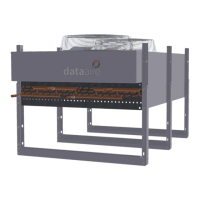20 • Air Cooled Condenser User Manual
5.0 WARRANTY
NOTE: See separate warranty certicate and registration card that is supplied with
each unit as part of the paperwork package.
6.0 PREVENTIVE MAINTENANCE
The operating life of the condenser can be extended by following a simple preventive maintenance
schedule. This schedule will reduce the possibility of failure of components and unnecessary mal-
function of the system. Although the service technicians must be thoroughly familiar with the special
design features of this equipment before attempting any service or repair, an experienced techni-
cian can perform certain simple maintenance functions to ensure normal, trouble-free operation.
6.1 Maintenance Functions
Monthly
Inspect condenser for obstruction to the inlet air side of the coil.
Inspect the motor/fan blade assemblies to ensure the bearings are
free and the motor mounts and fan(s) are secure.
Seasonally
Inspect electrical components for loose wire connections.
Inspect contactor contacts for pitting.
Inspect fan motor(s).
In the winter, do not allow snow to accumulate or build-up around the
sides or underneath the coil.
Bi-annually Clean the condenser coil of all debris that could restrict air flow.
Annually Check all refrigerant lines and connections for leaks or any sign of oil.
6.2 Electronically Commutated (EC) Fan Troubleshooting
Refer to the EC fan manufacturer’s Operating Instructions for detailed instructions, critical safety
information and troubleshooting instructions for this product.
6.3 Coil Cleaning
Keeping the outdoor coils clean is an important factor in maintaining peak eciency, reliability and
long life of the equipment. It is much easier to keep up on frequent cleanings rather than wait until
heavy build up has occurred which may create head pressure problems with the evaporator units.
6.3.1 When to Clean
Normal conditions typically dictate cleaning twice a year, spring and fall. On-site or area conditions
such as cottonwood trees, construction, etc., can increase cleaning frequency. On your standard
monthly preventive maintenance schedule, a visual inspection of the coil is recommended to moni-
tor conditions.
6.3.2 What to Use
The best overall coil cleaner to use is plain water. If the coil has been maintained and cleaned at
regular intervals, water is sucient to remove dirt and debris from the ns. Heavy build up on the
exterior of the ns can be removed with a brush. Water pressure from a garden hose and sprayer
usually works well.

